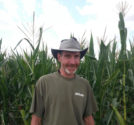Advertise Follow Us
Articles Tagged with ''Mycorrhizal Fungi''
No-Till Diversity Stretching from Border to Border
Seeding covers to sequester carbon and invite beneficial insects is helping build soil health and reducing input costs for Pierre, S.D., no-tiller Mark Weinheimer.
Read More
Digging Deep For Answers
Soil pits can help no-tillers answer questions about crop development, compaction and soil quality.
Read More
No-Till Corn Right Back Into The Old Corn Row
Illinois consultant designs coulter-and-row-cleaner setup to no-till corn into the previous year’s corn stalks and root balls.
Read More
Are Your No-Till Soils Getting A Balanced Diet?
Fertility expert Neal Kinsey covers all the basics necessary for nurturing soils so they become a thriving, productive living system.
Read More
No-Till’s “Super Glue” Works Wonders
The improved organic matter in many no-tilled soils may be due to this unique compound.
Read More









